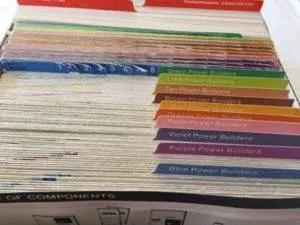A Box of Nostalgia: The SRA Reading Laboratory
Elizabeth Allen, May 4, 2017 (https://bookriot.com/a-box-of-nostalgia-the-sra-reading-laboratory/)
I’m the type of nerd who spent a good amount of my energy trying to will my teacher into giving us silent reading time. I’m the type of nerd who shot my hand up the instant the teacher called for someone to read aloud so fast I swear my rotator cuff is still jacked. And I’m the type of nerd who had my sights set on that well-worn box in the corner of my 4th grade classroom like it contained all the wisdom of man and womankind.
Ahhhh… the SRA Reading Laboratory. It resided deep in the hearts of all bookish elementary school students in the ’80s and ’90s… second only to that Holy Grail of Book Nerds, The Scholastic Book Fair. And the goal? To make your way through the rainbow and to prove that you’re the ultimate reader (I don’t remember having lots of friends in elementary school, now that I think about it).

The premise? This giant box of gloriousness was full of stories, each one assigned a particular color based on developmental milestones. Students initially took a brief test to determine what color (reading) level they should start at and then were given a story on card stock labeled with that color. After reading the story, you answered a series of reading comprehension questions related to what you just read. Successfully make your way through enough of these stories and you got to move on to the next color in the box. Educators used this as a way to both teach reading comprehension and to get a better understanding of the reading levels of their students. And let’s be honest, the air of competition helped some of us lazier students.
The SRA Reading Laboratory was designed in 1950 in rural Florida by Dr. Don H. Parker. A thirty-two children schoolhouse was the origin of an educational tool that would last for over 50 years. His previous experience in the psychological field would give him insight that made teaching all children from the same material seem antithetical to his knowledge of the developing minds of students. Driving through the countryside with an overloaded car, Parker visited K-12 students throughout rural Florida to administer reading tests. Faced with the daunting task of having to hand-grade 3,000 tests, Parker enlisted some of his school’s most intelligent seniors and they began to score the tests. In plotting the scores, the traditional bell curve began to materialize, giving his theory about the role psychology plays in education merit. Individual differences in learning capacity and speed had to be taken into account if educators were going to successfully raise a generation of readers. Dr. Parker’s school did not have the budget necessary to purchase entirely new and separate workbooks for each of the students based on their individual developmental levels. However, there was a series of workbooks containing 40 lessons each that could be purchased for a dollar. Parker proceeded to divide each of the lessons up into folders to be completed and then passed on to the next student. These folders were labeled with a color instead of a grade or number, as to avoid the stigma of reading levels. Each folder came with a key that gave the individual students the ability to grade their own work. All of these materials went into an old tomato box. And it was a success! The students in that country classroom began to not only focus on their education, but they began to take responsibility for their own education in a way rarely before seen. Within a week of schlepping around that tomato box, some of the students showed an improvement of up to three years in their reading abilities! After many rejections, Science Research Associates reached out to Dr. Parker in 1955, looking to add a reading component to their existing educational materials offering. In 1967, the SRA Reading Laboratory kit received its first 1,837 advanced orders at $39.95. Educators can still purchase a (much more technologically advanced) version of the SRA Reading Laboratory from McGraw-Hill Education. And to date, over one hundred million kits have been sold in over sixty-three countries. Dr. Don H. Parker died in 2000, but he changed how decades of children were taught to effectively read. And I personally suspect that this man is one of the reasons I, myself, fell in love with reading. Thank you, Dr. Parker!
